Sir Tim Berners-Lee
Early years

Tim Berners-Lee graduated from the Queen's College at Oxford University, England, 1976. Whilst there he built his first computer with a soldering iron, TTL gates, an M6800 processor and an old television. During the successive two years he will be working on distributed transaction systems, message relays, and bar code technology. Later, he wrote as well a typesetting software for intelligent printers and a multitasking operating system. He spent six months (From June 1980 to December 1980) as a consultant software engineer at CERN. While there, he wrote his first program for storing information using random associations. Named "Enquire"1 and never published, this program formed the conceptual basis for the future development of what would later become the “World Wide Web”.
From 1981 until 1984, Tim worked on real time control firmware, graphics and communications software, and a generic macro language. In 1984, he took up a fellowship at CERN, to work on distributed real-time systems for scientific data acquisition and system control. Among other things, he worked on FASTBUS system software and designed a heterogeneous remote procedure call system.
His work at CERN

In 1989, while working at at CERN, the European Particle Physics Laboratory in Geneva, Switzerland, Tim Berners-lee proposed a global hypertext project, to be known as the World Wide Web. He wrote the first World Wide Web server, "httpd", and the first client, "WorldWideWeb" a WYSIWYG2 hypertext browser/editor which ran in the NeXTStep environment. This work was started in October 1990, and the program "WorldWideWeb" first made available within CERN in December, and on the Internet at large in the summer of 1991.
External Links
- Enquire - Wikipedia [Visited on 06/11/2014]
- What You See Is What You Get - Wikipedia [Visited on 06/11/2014]
- Tim Berners-Lee's tweet at the 2012 London Olympics. [Visited on 06/11/2014]